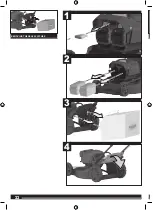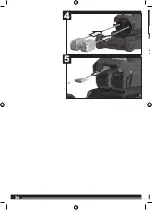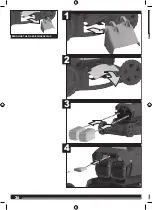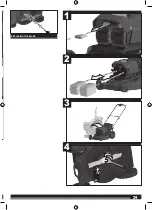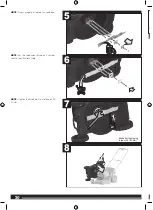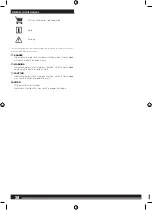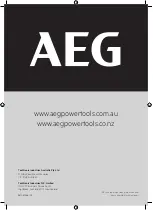
36
36
speed for which it was designed.
Stop the blade when crossing gravel surfaces.
Do not pull the product backward unless absolutely necessary. If you
must back the product away from a wall or obstruction, first look down
and behind to avoid tripping or pulling the product over your feet.
Turn off the motor and allow the blade to stop if the mower has to be
tilted for transportation when crossing surfaces other than grass, and
when transporting the product to and from the area to be mowed.
Never use the product with defective guards or shields, or without
safety devices, such as deflectors and grass catcher, in place.
Do not tilt the product when turning on the motor or while the motor
is running. Tilting the product exposes the blade and increases the
probability of objects being thrown.
Turn on the motor carefully according to instructions and keep hands
and feet away from the blades. Keep clear of the discharge opening
at all times. Do not start the product when standing in front of the
discharge opening.
Do not put hands or feet near or under rotating parts. Keep clear of
the discharge opening at all time.
Never pick up or carry the product while it is running.
Turn off the product, and remove safety key and the battery pack.
Make sure that all moving parts have come to a complete stop:
■
before leaving the product unattended (including disposal of
grass clippings)
■
before cleaning blockages or unclogging the discharge chute
■
before checking, cleaning or working on the product
■
before removing the grass catcher or opening the grass discharge
chute cover
■
after striking a foreign object (inspect the product for damage
and make repairs as necessary before restarting and operating
the product)
■
If the product starts to vibrate abnormally (check immediately):
–
inspect for damage, particularly the blades
–
replace or repair any damaged parts
–
check for and tighten any loose parts
Avoid holes, ruts, bumps, rocks, property stakes, or other hidden
objects. Uneven terrain could cause a slip-and-fall accident.
Always ensure that the motor control cable is never trapped, pinched,
or otherwise damaged during assembly or when folding the handle.
ADDITIONAL BATTERY SAFETY WARNINGS
WARNING!
To reduce the risk of fire, personal injury, and product
damage due to a short circuit, never immerse your tool, battery pack,
or charger in fluid or allow fluid to flow inside them. Corrosive or
conductive fluids, such as seawater, certain industrial chemicals, and
bleach or bleach-containing products, etc., can cause a short circuit.
OVERLOAD, OVERHEAT, AND TILT PROTECTION
The product has an overload protection device. When overloading is
detected, the product automatically turns off. If the overload protector
is actuated, the on/off trigger must be released. Press the start button,
and squeeze the on/off trigger to restart the product.
The product has overheat protection. Excessive temperatures cause
the battery pack to stop powering the product. If the battery pack
is too warm, allow it to cool down before resuming operation. If the
product still does not work, recharge the battery pack.
NOTE:
The battery pack LED indicator does not work if the battery
protection feature has caused the battery pack to stop powering the
product. Release the on/off lever or remove the battery pack from
the product, and the battery pack LED indicator will resume normal
function.
The tilt protection function stops the product if it is tilted beyond 40°,
for about 7 seconds. The product does not function if the tilt angle
limit is exceeded or if the product is in the vertical storage position.
RESIDUAL RISKS
Even when the product is used as prescribed, it is still impossible
to completely eliminate certain residual risk factors. The following
hazards may arise during use and the operator should pay special
attention to avoid the following:
■
injury caused by vibration
–
Always use the right tool for the job. Use designated handles
and restrict working time and exposure.
■
injury caused by exposure to noise
–
Exposure to noise can cause hearing injury. Wear ear
protection and limit exposure.
■
injury caused by contact with the blades.
■
injury from thrown objects
RISK REDUCTION
It has been reported that vibrations from handheld tools may
contribute to a condition called Raynaud’s Syndrome. Symptoms
may include tingling, numbness, and blanching of the fingers, usually
apparent upon exposure to cold. Hereditary factors, exposure to
cold and dampness, diet, smoking, and work practices are all thought
to contribute to the development of these symptoms. There are
measures that can be taken by the operator to possibly reduce the
effects of vibration:
■
Keep your body warm in cold weather. When operating the
product wear gloves to keep the hands and wrists warm. It is
reported that cold weather is a major factor contributing to
Raynaud’s Syndrome.
■
After each period of operation, exercise to increase blood
circulation.
■
Take frequent work breaks. Limit the amount of exposure per day.
If you experience any of the symptoms of this condition, immediately
discontinue use and see your doctor.
WARNING!
Injuries may be caused, or aggravated, by prolonged
use of a tool. When using any tool for prolonged periods, ensure you
take regular breaks.
TRANSPORTATION AND STORAGE
Turn off the product, and remove the safety key and the battery pack.
Make sure that all moving parts have come to a complete stop. Allow
the product to cool down before storing or transporting.
Remove all foreign materials from the product. Store the product in
a cool, dry, and well-ventilated place that is inaccessible to children.
Keep the product away from corrosive agents such as garden
chemicals and de-icing salts. Do not store the product outdoors.
For transportation in vehicles, remove safety key, and secure the
product against movement or falling to prevent injury to persons or
damage to the product.
WARNING!
Use extreme caution when lifting or tilting the
product for maintenance, cleaning, storage, or transportation. The
blade is sharp. Keep all body parts away from the blade while it is
exposed.
TRANSPORTING LITHIUM BATTERIES
Transport the battery in accordance with local and national provisions
and regulations.
Follow all special requirements on packaging and labelling when
transporting batteries by a third party. Ensure that no batteries can
come in contact with other batteries or conductive materials while
in transport by protecting exposed connectors with insulating, non-
conductive caps or tape. Do not transport batteries that are cracked
or leaking. Check with the forwarding company for further advice.
MAINTENANCE
WARNING!
Use only original manufacturer’s replacement parts,
accessories and attachments. Failure to do so can cause injury, can
contribute to poor performance, and may void your warranty.
WARNING!
Servicing requires extreme care and knowledge and
should be performed only by a qualified service technician. Have
the product serviced by an authorised service centre only. When
servicing, use only original replacement parts.
Turn off the product, and remove the safety key and the battery pack.
Make sure that all moving parts have come to a complete stop before
any cleaning or maintenance task.
You may make adjustments and repairs described in this manual.
For other repairs, have the product serviced by an authorised service
centre only.
Frequently check the grass catcher for wear or deterioration.
After each use, clean the product with a soft, dry cloth. Any part that
is damaged should be properly repaired or replaced by an authorised
service centre.
Check all nuts, bolts, and screws at frequent intervals for proper
tightness to ensure that the product is in safe working condition.
Be careful during adjustment of the product to prevent entrapment
of the fingers between moving blades and fixed parts of the product.
When servicing the blades, be aware that even though the power
source is turned off, the blades can still be moved.
The blade on the product is sharp. Use extreme caution and wear
heavy-duty gloves when fitting, replacing, cleaning, or checking bolt
security.
Replace damaged blades and bolts in sets to preserve balance.
CLEARING BLOCKAGES
■
Turn off the product, and remove the safety key and the battery
pack. Make sure that all moving parts have come to a complete
stop.
■
Always wear heavy-duty gloves when checking or clearing a
blockage.
■
The blades are sharp, and the blockage itself could be a sharp
object.
■
Remove the grass catcher, check for and carefully clear
obstructions.
Summary of Contents for ALM58LI402
Page 1: ...ALM58LI402 Original instructions ...
Page 3: ...3 3 x 1 x 1 x 1 x 1 x 1 x 2 x 1 x 1 x 1 ALM58LI402 ...
Page 10: ...10 10 1 2 3 4 UNFOLDING THE HANDLES ...
Page 11: ...11 11 7 6 5 ...
Page 14: ...14 14 Max 15 START STOP OPERATING THE PRODUCT INS ...
Page 15: ...15 15 3 4 1 2 INSTALLING THE MULCH PLUG ...
Page 16: ...16 16 5 RE ...
Page 17: ...17 17 1 2 3 4 REMOVING THE MULCH PLUG ...
Page 18: ...18 18 5 INS To a catch top h Inser then ...
Page 20: ...20 20 6 5 4 ...
Page 21: ...21 21 8 7 ...
Page 22: ...22 22 3 1 2 4 REMOVING THE GRASS CATCHER AD ...
Page 23: ...23 23 3 1 2 ADJUSTING THE CUTTING HEIGHT ...
Page 24: ...24 24 5 4 INS NOT the ...
Page 26: ...26 26 2 1 4 3 REMOVING THE SIDE DISCHARGE PLUG AD ...
Page 27: ...27 27 3 1 2 ADJUSTING THE HANDLE HEIGHT ...
Page 28: ...28 28 5 4 RE ...
Page 29: ...29 29 3 1 2 4 REPLACING THE BLADE ...
Page 31: ...31 31 g 3 4 1 2 STORING THE PRODUCT ...
Page 32: ...32 32 8 7 5 6 ...
Page 33: ...33 33 12 10 11 9 ...
Page 39: ...39 39 ...

